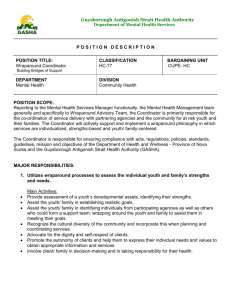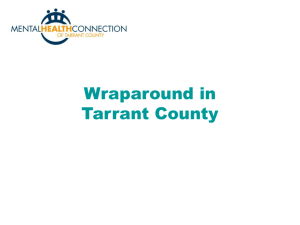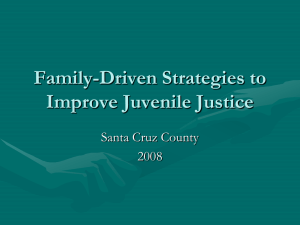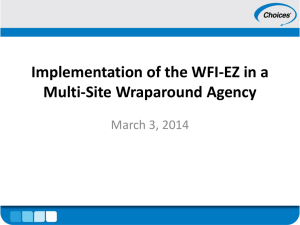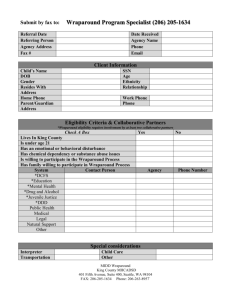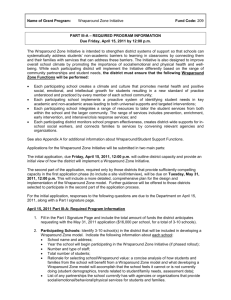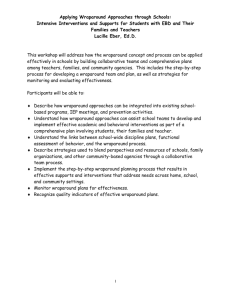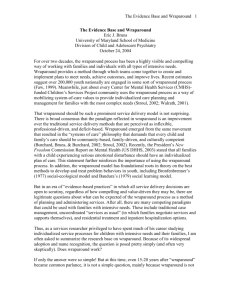Related Readings - Illinois Statewide Technical Assistance
advertisement
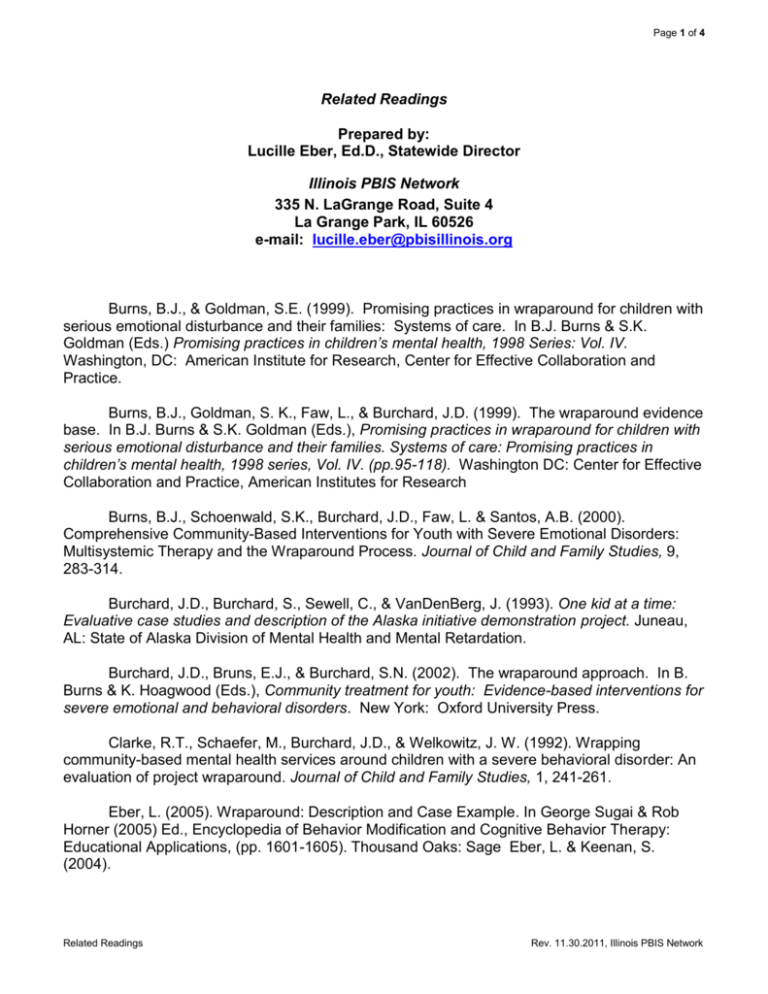
Page 1 of 4 Related Readings Prepared by: Lucille Eber, Ed.D., Statewide Director Illinois PBIS Network 335 N. LaGrange Road, Suite 4 La Grange Park, IL 60526 e-mail: lucille.eber@pbisillinois.org Burns, B.J., & Goldman, S.E. (1999). Promising practices in wraparound for children with serious emotional disturbance and their families: Systems of care. In B.J. Burns & S.K. Goldman (Eds.) Promising practices in children’s mental health, 1998 Series: Vol. IV. Washington, DC: American Institute for Research, Center for Effective Collaboration and Practice. Burns, B.J., Goldman, S. K., Faw, L., & Burchard, J.D. (1999). The wraparound evidence base. In B.J. Burns & S.K. Goldman (Eds.), Promising practices in wraparound for children with serious emotional disturbance and their families. Systems of care: Promising practices in children’s mental health, 1998 series, Vol. IV. (pp.95-118). Washington DC: Center for Effective Collaboration and Practice, American Institutes for Research Burns, B.J., Schoenwald, S.K., Burchard, J.D., Faw, L. & Santos, A.B. (2000). Comprehensive Community-Based Interventions for Youth with Severe Emotional Disorders: Multisystemic Therapy and the Wraparound Process. Journal of Child and Family Studies, 9, 283-314. Burchard, J.D., Burchard, S., Sewell, C., & VanDenBerg, J. (1993). One kid at a time: Evaluative case studies and description of the Alaska initiative demonstration project. Juneau, AL: State of Alaska Division of Mental Health and Mental Retardation. Burchard, J.D., Bruns, E.J., & Burchard, S.N. (2002). The wraparound approach. In B. Burns & K. Hoagwood (Eds.), Community treatment for youth: Evidence-based interventions for severe emotional and behavioral disorders. New York: Oxford University Press. Clarke, R.T., Schaefer, M., Burchard, J.D., & Welkowitz, J. W. (1992). Wrapping community-based mental health services around children with a severe behavioral disorder: An evaluation of project wraparound. Journal of Child and Family Studies, 1, 241-261. Eber, L. (2005). Wraparound: Description and Case Example. In George Sugai & Rob Horner (2005) Ed., Encyclopedia of Behavior Modification and Cognitive Behavior Therapy: Educational Applications, (pp. 1601-1605). Thousand Oaks: Sage Eber, L. & Keenan, S. (2004). Related Readings Rev. 11.30.2011, Illinois PBIS Network Page 2 of 4 Eber, L. (2003). The art and science of wraparound: Completing the continuum of schoolwide behavioral support. Bloomington, IN: Forum on Education at Indiana University. Eber, L. (1999). Family Voice, Teacher Voice: Finding Common Ground through the Wraparound Process. Claiming Children. The Federation of Families for Children’s Mental Health, Alexandria, VA. Eber, L. (1996). Restructuring schools through wraparound approach: The LADSE Experience. In R. J. Illback & C. M. Nelson (Eds.), School-based services for students with emotional and behavioral disorders (pp. 139-154). Binghamton, NY: Haworth. Eber, L. , Breen, K., Rose, J., Unizycki, R.M, London, T.H. (2008). “Wraparound as a Tertiary Intervention within a School-wide System of Positive Behavior Support”. Teaching Exceptional Children 40 (6), 16-22. Eber, L., & Hyde, K. (2006). Integrating data-based decision into the wraparound process within a system of school-wide positive behavior supports (PBS). Summary of Conference Proceedings for the 18th Annual Research Conference for Children’s Mental Health. Tampa, FL. Eber, L., Hyde, K., Rose, J., Breen, K., Mc Donald, D. and Lewandowski, H. (2008). Completing the Continuum of School-wide Positive Behavior Support: Wraparound as a Tertiary Level Intervention. In Sailor, W., Dunlap, G., Sugai, G. and Horner, R. (Eds.), Handbook of Positive Behavior Support. Springer. NY, NY. Eber, L. & Keenan, S. (2004). Collaboration with other agencies. Wraparound and systems of care for children and youths with emotional and behavior disorders. In B. Rutherford, Jr., M. Quinn, R. Mathur (Eds.), Handbook of Research in Emotional and Behavioral Disorders, New York: Guilford Press. Eber, L. & Nelson, C.M. (1997). Integrating Services for Students with Emotional and Behavioral Needs through School-Based Wraparound Planning. American Journal of Orthopsychiatry. 67, pp.385-395. Eber, L., Nelson, C.M., & Miles, P. (1997). School-based wraparound for students with emotional and behavioral challenges. Exceptional Children, 63, 539-555. Eber, L., Osuch, R., & Redditt, C.A. (1996). School-based applications of the wraparound process: Early results on service provision and student outcomes. Journal of Child and Family Studies, 5, 83-99. Eber, L., Sugai, G., Smith, C., & Scott, T. M. (2002). Wraparound and Positive Behavioral Interventions and Supports in the Schools. Journal of Emotional and Behavioral Disorders, 10, 171-180. Related Readings Rev. 11.30.2011, Illinois PBIS Network Page 3 of 4 Freeman, R., Eber, L., Anderson, C., Irvin, L., Horner, R., Bounds, M., & Dunlap, G. (2006). Building Inclusive School Cultures Using School-Wide Positive Behavior Support: Designing Effective Individual Support Systems for Students with Disabilities. Research and Practice for Persons with Severe Disabilities, 31, 4-17. Goldman, S.K. (1999). The conceptual framework for wraparound. . In B.J. Burns & S.K. Goldman (Eds.), Promising practices in wraparound for children with serious emotional disturbance and their families. Systems of care: Promising practices in children’s mental health, 1998 series, Vol. IV. (pp.27-34). Washington DC: Center for Effective Collaboration and Practice, American Institutes for Research. Hawken, L.S. & O’Neill, R.E. (2006). Including Students With Severe Disabilities in All Levels of School-Wide Positive Behavior Support. Research and Practice for Persons with Severe Disabilities, 31, 46-53. Kendziora, K., Bruns, E., Osher, D., Pacchiano, D., & Meja, B. (2001). Systems of care promising practices in children’s mental health, 2001 series, Volume 1. Washington, DC: American Institute for Research, Center for Effective Collaboration and Practice. Kincaid, D. & Fox, L. (2002). Person-centered planning and positive behavior support. In S. Holburn & P. Vietze (Eds.), Person-centered planning: Research, practice, and future directions (pp. 29-49). Baltimore: Brookes. Malloy, J., Cheney, D., & Cormier, G. (1998). Interagency collaboration and the transition to adulthood of students with emotional or behavioral disabilities. Education and Treatment of Children, 1, 303-320. Miles, P., Bruns, E.J., Osher, T.W., Walker, J.S., & National Wraparound Initiative Advisory Group (2006). The Wraparound process user’s guide: A handbook for families. Portland, OR: National Wraparound Initiative, Research and Training Center on Family Support and Children’s Mental Health, Portland State University. O’Brien, C.L. & O’Brien, J. (2002). The origins of person-centered planning: A community of practice perspective. In Holburn, S., Vietze, P. M., (Eds.). Person-centered planning: Research, practice, and future directions. (pp. 3-27). Baltimore: Brookes. Rosenblatt, A. (1996). Bows and ribbons, tape and twine: Wrapping the wraparound process for children with multi-system needs. Journal of Child and Family Studies, 5, 101-116. Scott, T., & Eber, L. (2003). Functional assessment and wraparound as systemic school processes: Primary, secondary, and tertiary systems examples. Journal of Positive Behavior Supports, 5, 131-143. Turnbull, A., Edmonson, H., Griggs, P., Wickham, D., Sailor, W., Freeman, R., et al., (2002). A blueprint for schoolwide positive behavior support: Implementation of three components. Exceptional Children, 68, 377-402. Related Readings Rev. 11.30.2011, Illinois PBIS Network Page 4 of 4 VanDenBerg, J.E. & Grealish, E.M. (1996). Individualized services and supports through the wraparound process: Philosophy and procedures. Journal of Child and Family Studies, 5, 721. VanDenBerg, J., (1999). History of the wraparound process. In B.J. Burns and S.K. Goldman (Eds.), Promising practices in wraparound for children with serious emotional disturbance and their families: Vol. IV (pp.19-26). Washington DC: Center for Effective Collaboration and Practice, American Institute for Research. Walker, J.S. & Schutte, K.M. (2004). Practice and process in wraparound teamwork. Journal of Emotional and Behavioral Disorders, 12, 182-192. Related Readings Rev. 11.30.2011, Illinois PBIS Network
